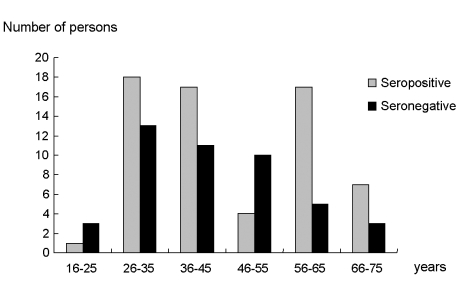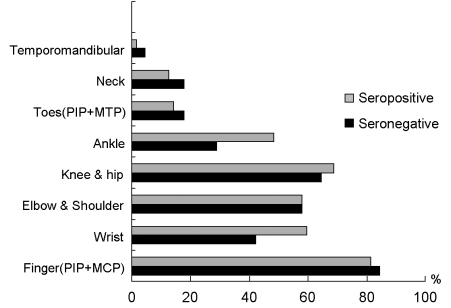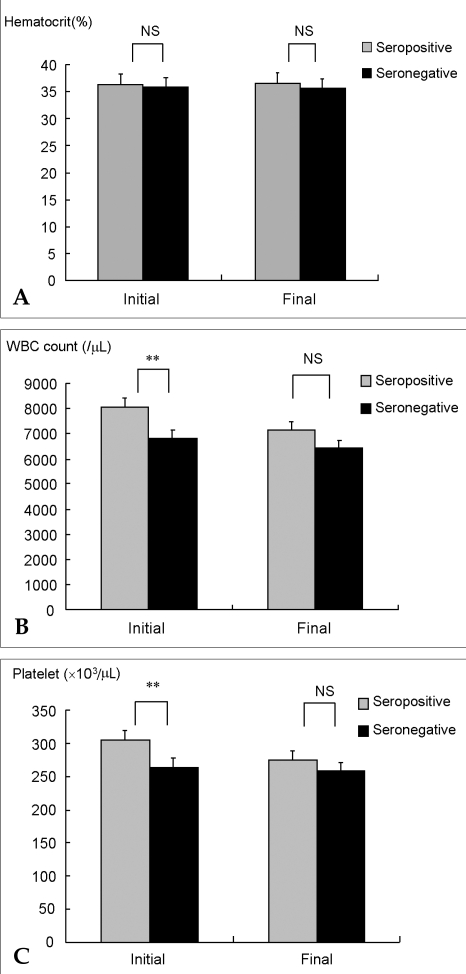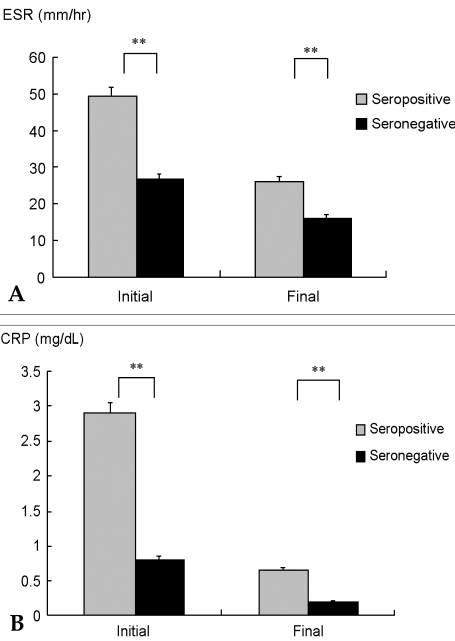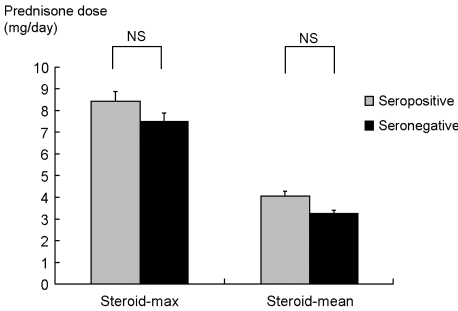Yonsei Med J.
2005 Aug;46(4):464-470. 10.3349/ymj.2005.46.4.464.
Rheumatoid Factor is a Marker of Disease Severity in Korean Rheumatoid Arthritis
- Affiliations
-
- 1Department of Allergy and Rheumatology, Ajou University School of Medicine, Suwon, Korea. chsuh@ajou.ac.kr
- 2Department of Radiology, Ajou University School of Medicine, Suwon, Korea.
- KMID: 1716514
- DOI: http://doi.org/10.3349/ymj.2005.46.4.464
Abstract
- Serum rheumatoid factor (RF) is important in the diagnosis and prognosis of rheumatoid arthritis (RA). The purpose of this study is to compare the clinical characteristics and treatment patterns of RA according to the presence of RF in Korean patients. A retrospective analysis was performed on the records of 109 patients who were followed for at least 2 years, among 230 RA patients who visited at the rheumatology clinic in Ajou University Hospital and who fulfilled the 1987 revised American College of Rheumatology criteria for RA. Sixty-four patients were RF positive (58.7%) and 91 patients were female (83.5%). There was no significant difference in demographic characteristics, joint involvements, or percentage of morning stiffness between seropositive and seronegative groups. Antinuclear antibody was detected more frequently in the seropositive group (p < 0.05). At initial diagnosis, the seropositive group had higher white blood cell and platelet counts than the seronegative group (p < 0.01). However, the difference was disappeared at the last follow-up. Inflammatory markers such as ESR and CRP were also higher at diagnosis in the seropositive group (p < 0.01). These inflammatory markers were still greater than the seronegative group at the last follow-up (p < 0.01). There was no significant difference in the use of disease modifying antirheumatic drug (DMARD) and steroid dosage between groups. However, DMARD combination therapy was more commonly used in the seropositive group (p < 0.05), especially triple DMARD combination. These results suggest that disease activity is more severe in the seropositive than the seronegative group, and more aggressive treatments are needed in the seropositive group.
Keyword
MeSH Terms
Figure
Cited by 1 articles
-
Rheumatoid Factor Positivity is Associated with Lower Bone Mass in Korean Male Health Examinees without Clinically Apparent Arthritis
Jiwon Hwang, Joong Kyong Ahn, Jaejoon Lee, Eun-Mi Koh, Hoon-Suk Cha
J Rheum Dis. 2019;26(1):31-40. doi: 10.4078/jrd.2019.26.1.31.
Reference
-
1. Deal CL, Meenan RF, Goldenberg DL, Anderson JJ, Sack B, Pastan RS, et al. The clinical features of elderly-onset rheumatoid arthritis. Arthritis Rheum. 1985; 28:987–994. PMID: 4038365.2. Fleming A, Crown JM, Corbett M. Prognostic value of early features in rheumatoid disease. Br Med J. 1976; 1:1243–1245. PMID: 1083760.
Article3. Van der Heijde DM, Van Riel PL, Van Rijswijk MH, Van de Putte LB. Influence of prognostic features on the final outcome in rheumatoid arthritis: a review of literature. Semin Arthritis Rheum. 1988; 17:284–292. PMID: 3068804.4. Waaler E. On the occurrence of a factor in human serum activating the specific agglutination of sheep blood corpuscles. Acta Pathol Microbiol Scand. 1940; 17:172–188.
Article5. Pike RM, Sulkin SE, Coggeshall HC. Serological reactions in rheumatoid arthritis. II. Concerning the nature of the factor in rheumatoid arthritis serum responsible for increased agglutination of sensitized sheep erythrocytes. J Immunol. 1949; 63:448–463.6. Scott DL. Prognostic factors in early rheumatoid arthritis. Rheumatology. 2000; 39:24–29. PMID: 11001376.
Article7. Kaltenhauser S, Wagner U, Schuster E. Immunogenetic markers and seropositivity predict radiological progression in early rheumatoid arthritis independent of disease activity. J Rheumatol. 2001; 28:735–744. PMID: 11327243.8. Drosos AA, Lanchbury JS, Panayi GS, Moutsopoulos HN. Rheumatoid arthritis in Greek and British patients: a comparative clinical radiological and serological study. Arthritis Rheum. 1992; 35:745–748. PMID: 1622412.9. Papadopoulos IA, Katsimbri P, Katsaraki A, Temekonidis T, Georgiadis A, Drosos AA. Clinical course and outcome of early rheumatoid arthritis. Rheumatol Int. 2001; 20:205–210. PMID: 11518041.10. Masi AT, Maldonado-Cocco JA, Kaplan SB, Feigenbaum SL, Chandler RW. Prospective study of the elderly course of rheumatoid arthritis in young adults: comparison of patients with and without rheumatoid factor positivity at entry and identification of variables correlating with outcomes. Semin Arthritis Rheum. 1976; 5:299–326. PMID: 1273600.11. Amos RS, Constable TJ, Crockson RA, Crockson AP, McConkey B. Rheumatoid arthritis: relation of serum C-reactive protein and erythrocyte sedimentation rates to radiographic changes. Br Med J. 1977; 22:195–197. PMID: 832072.
Article12. Van Zeben D, Hazes JMW, Zwinderman AH, Cats A, Van der Voort EAM, Breadveld FC. Clinical significance of rheumatoid factor in early rheumatoid arthritis-results of a follow up study. Ann Rheum Dis. 1992; 51:1029–1035. PMID: 1417131.13. Sjoblom KG, Saxne T, Petterson H, Wollheim FA. Factors related to the progression of joint destruction in rheumatoid arthritis. Scand J Rheumatol. 1984; 13:21–27. PMID: 6719058.14. Nishimura S, Nishiya K, Hisakawa N, Chikazawa H, Ookubo S, Nakatani K, et al. Positivity for antinuclear antibody in patients with advanced rheumatoid arthritis. Acta Med Okayama. 1996; 50:261–265. PMID: 8914679.15. Paulus HE, Wiesner J, Bulpitt KJ, Patnaik M, Law J, Park GS, et al. Autoantibodies in early seropositive rheumatoid arthritis, before and during disease modifying antirheumatic drug treatment. J Rheumatol. 2002; 29:2513–2520. PMID: 12465144.16. Saraux A, Allian J, Guedes C, Valls I, Baron D, Youinou P, et al. Clinical, laboratory, and radiographic features of rheuamtoid arthritis with and without nodules. Rev Rhum Engl Ed. 1997; 64:11–17. PMID: 9051854.17. Kim NH, Yang KH, Yang IH. Clinical significance of the immunological tests in rheumatoid arthritis. Yonsei Med J. 1989; 30:23–29. PMID: 2741472.
Article18. Mottonen T, Paimela L, Ahonen J, Helve T, Hannonen P, Leirisalo-Repo M. Outcome in patients with early rheumatoid arthritis treated according to the "sawtooth" strategy. Arthritis Rheum. 1996; 39:996–1005. PMID: 8651994.
- Full Text Links
- Actions
-
Cited
- CITED
-
- Close
- Share
- Similar articles
-
- Clinical significance of rheumatoid factor in juvenile rheumatoid arthritis
- Cytokines in rheumatoid arthritis
- Medical Treatment of Rheumatoid Arthritis
- Diagnostic Signification of Antiperinuclear Factor(APF) in Rheumatoid Arthritis
- Association of Anti-cyclic Citrullinated Peptide (CCP) Antibodies and Functional Status in Rheumatoid Arthritis

